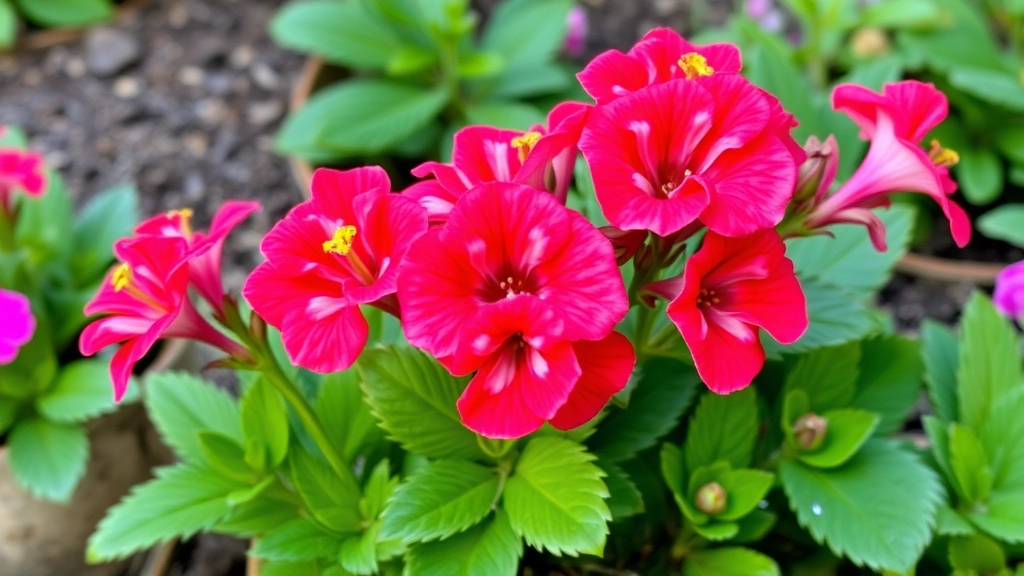Kalanchoe Flaming Katy Care Guide
If you’re looking to keep your Kalanchoe Flaming Katy thriving, you’re in the right place. This vibrant houseplant, known for its colourful, long-lasting blooms, is a favourite among plant enthusiasts. But what does it take to keep it looking its best? From ideal growing conditions to watering schedules and pruning techniques, we’ve got you covered.
Understanding Your Flaming Katy
Understanding the needs of your Flaming Katy is crucial for its health and longevity. Proper lighting, soil preferences, and effective propagation methods can make all the difference. Whether you’re a seasoned plant parent or a newbie, these tips will help you maintain a flourishing Kalanchoe Flaming Katy, ensuring it remains a stunning addition to your indoor garden.
Ideal Growing Conditions for Flaming Katy
Are you struggling to keep your Flaming Katy thriving? Understanding the ideal growing conditions is essential for nurturing this vibrant succulent.
Flaming Katy, or Kalanchoe blossfeldiana, prefers a warm, stable environment to flourish. Here are the key factors to consider:
Temperature
- Optimal Range: 18°C to 24°C (65°F to 75°F)
- Avoid Extremes: Protect from temperatures below 10°C (50°F) and avoid drafts. For more detailed information on the ideal temperature, check out the Ideal Temperature for Kalanchoe Blossfeldiana Growth.
Humidity
- Low Humidity: These plants thrive in dry conditions, making them ideal for indoor settings.
- Air Circulation: Ensure good airflow around the plant to prevent fungal issues. Learn more about Flowering Kalanchoe Care Tips for Thriving Blooms.
Soil
- Well-Draining Soil: Use a cactus or succulent mix to prevent root rot.
- pH Level: Aim for a slightly acidic to neutral pH (6.0 to 7.0).
Potting
- Container Choice: Choose pots with drainage holes to allow excess water to escape.
- Repotting: Consider repotting every couple of years to refresh the soil and provide more space.
II. Watering Schedule and Soil Preferences

So, you’ve got your Flaming Katy, and you’re probably wondering how to keep it thriving, right?
Let’s dive into the nitty-gritty of watering and soil preferences.
Watering Schedule
Finding the right watering routine is key to keeping your Flaming Katy happy.
- Frequency: Water every 2-3 weeks during the growing season (spring and summer).
- Check the Soil: Stick your finger about an inch into the soil. If it feels dry, it’s time to water.
- Less is More: Remember, Flaming Katy prefers to be on the drier side. Overwatering can lead to root rot, so it’s better to underwater than overdo it.
Soil Preferences
Now, let’s chat about soil. The right mix can make all the difference.
- Well-Draining Soil: Use a cactus or succulent mix, or make your own with:
- 50% potting soil
- 25% perlite
- 25% sand
- pH Level: Aim for a slightly acidic to neutral pH (around 6.0 to 7.0).
- Pot Choice: A pot with drainage holes is a must. This helps excess water escape, keeping your roots healthy.
By getting your watering schedule and soil preferences right, you’ll set the stage for a vibrant Flaming Katy.
Lighting Needs for Optimal Growth
When it comes to ensuring your Flaming Katy thrives, lighting is a key factor that cannot be overlooked.
Many plant enthusiasts often wonder, “How much light does my Flaming Katy need?”
How to Prune and Deadhead Flaming Katy

Pruning and deadheading are essential practices for maintaining the health and beauty of your Flaming Katy (Kalanchoe blossfeldiana).
You may wonder, when is the right time to prune, and how do I go about it effectively?
Understanding Pruning
Pruning helps to promote new growth and prevent overcrowding. Here’s how to do it:
- Timing: Prune after the blooming period, typically in late spring or early summer.
- Tools: Use clean, sharp scissors or pruning shears to avoid damaging the plant.
- Technique:
- Remove any dead or yellowing leaves.
- Cut back leggy stems to encourage bushier growth.
- Aim to maintain a balanced shape, trimming any excessively long stems.
The Importance of Deadheading
Deadheading is the process of removing spent flowers to encourage further blooming. Here’s a simple guide:
- When to Deadhead: As soon as flowers begin to wilt, ideally before they set seed.
- How to Deadhead:
- Pinch off the faded flowers at their base.
- This encourages the plant to focus its energy on producing new blooms rather than seed production.
Benefits of Pruning and Deadheading
- Enhanced Growth: Regular pruning stimulates new growth.
- Extended Blooming Period: Deadheading promotes more flowers and prolongs the blooming cycle.
- Improved Aesthetics: A well-pruned plant looks tidy and vibrant.
Propagation Methods: Stem Cuttings and Offsets
When it comes to expanding your collection of Flaming Katy, understanding propagation methods is essential. Many plant enthusiasts often wonder how to effectively propagate their beloved succulents.
Stem Cuttings
One of the most popular methods for propagating Flaming Katy is through stem cuttings. This approach is straightforward and can yield excellent results. Here’s how to do it:
- Select a Healthy Stem: Look for a robust, healthy stem that has several leaves.
- Make the Cut: Using clean, sharp scissors or pruning shears, cut a 4-6 inch section from the stem. Ensure the cut is made just below a leaf node for the best chance of rooting.
- Let it Callous: Place the cutting in a dry area for a few days. This allows the cut end to callous over, reducing the risk of rot when planted.
- Planting: Once calloused, plant the cutting in well-draining soil, such as a cactus mix. Water lightly to settle the soil around the cutting.
- Watering: Keep the soil slightly moist but not soggy. Roots should develop within a few weeks.
Offsets
Another effective method for propagating Flaming Katy is through offsets. Offsets are small plants that grow at the base of the parent plant. Here’s how to successfully propagate using offsets:
- Identify Offsets: Look for small rosettes at the base of the parent plant. These should be healthy and well-formed.
- Remove Offsets: Gently twist or cut the offset from the parent plant, ensuring you take some roots along with it.
- Prepare for Planting: Allow the offset to dry for a day or two, similar to stem cuttings, to prevent rot.
- Planting: Plant the offset in a pot with well-draining soil, ensuring it is stable.
- Care: Water lightly and place it in a bright location, allowing it to establish roots.
By mastering these propagation methods, you can enjoy a thriving collection of Flaming Katy plants. For more detailed guidance, check out our Flaming Katy care and propagation tips and learn about other Kalanchoe succulents with red flowers to diversify your collection.
Common Issues and How to Address Them

So, you’ve got your Flaming Katy thriving, but sometimes it can throw a curveball.
Ever noticed those leaves turning yellow or wilting?
Or maybe your plant just isn’t blooming like it used to?
No worries, let’s tackle some common issues you might face and how to fix them.
1. Yellow Leaves
Causes:
- Overwatering
- Poor drainage
- Nutrient deficiency
Solutions:
- Check Your Watering: If the soil feels soggy, hold back on the water.
- Ensure Drainage: Make sure your pot has drainage holes.
- Feed Wisely: A balanced fertiliser can help perk up those leaves.
2. Wilting or Drooping
Causes:
- Underwatering
- Sudden temperature changes
Solutions:
- Watering Check: If the soil is dry, give your plant a good drink.
- Temperature Control: Keep it in a stable environment, away from drafts or heat sources.
3. Lack of Blooms
Causes:
- Insufficient light
- Improper pruning
Solutions:
- Light Check: Ensure it’s getting enough bright, indirect sunlight.
- Prune Right: Regularly deadhead spent flowers to encourage new blooms.
4. Pest Problems
Common Pests:
- Mealybugs
- Aphids
Solutions:
- Inspect Regularly: Check the undersides of leaves.
- Natural Remedies: Use insecticidal soap or neem oil to combat infestations.
5. Root Rot
Causes:
- Overwatering
- Poor soil aeration
Solutions:
- Repot if Necessary: If you suspect root rot, repot in fresh, well-draining soil.
- Water Sparingly: Let the soil dry out between waterings.
1. Optimal Fertilisation
- Use a balanced fertiliser during the growing season.
- Opt for a fertiliser with a higher phosphorus content to promote flowering.
- Fertilise every 4-6 weeks to keep nutrients flowing.
2. Temperature Control
- Flaming Katy thrives in temperatures between 18-24°C.
- Avoid exposing them to drafts or sudden temperature changes, as this can hinder blooming.
3. Proper Watering Techniques
- Allow the soil to dry out between waterings.
- Overwatering can lead to root rot, which stifles flowering.
- Water less frequently during the winter months.
4. Pruning for Growth
- Prune after the flowering period to encourage new growth.
- Regularly deadhead spent flowers to promote further blooming.
5. Lighting Conditions
- Ensure they receive bright, indirect sunlight for at least 6 hours a day.
- A lack of light can result in fewer blooms.
6. Pest Management
- Keep an eye out for pests like aphids and mealybugs, which can affect flowering.
- Treat any infestations promptly with appropriate organic solutions.
For more detailed advice on how to care for your Kalanchoe after flowering, check out our [complete guide to postflowering Kalanchoe care](https://planthq.org/postflowering-kalanchoe-care-pruning-watering-reblooming-tips/). Additionally, if you’re facing issues with your plant not blooming as expected, our article on [why your Kalanchoe isn’t flowering](https://planthq.org/why-your-kalanchoe-isnt-flowering-causes-and-solutions/) provides valuable insights and solutions.
FAQs about Kalanchoe Flaming Katy
What is the ideal watering schedule for Flaming Katy?
The ideal watering schedule for Flaming Katy is every 2-3 weeks during the growing season (spring and summer). Always check the soil by sticking your finger about an inch deep; if it feels dry, it’s time to water.
What type of soil is best for Flaming Katy?
Flaming Katy thrives in well-draining soil. A cactus or succulent mix works well, or you can create your own mix with 50% potting soil, 25% perlite, and 25% sand. Aim for a slightly acidic to neutral pH (around 6.0 to 7.0).
How do I prune and deadhead Flaming Katy?
Prune Flaming Katy after the blooming period, typically in late spring or early summer. Use clean, sharp scissors or pruning shears to remove dead or yellowing leaves and cut back leggy stems to encourage bushier growth. Deadhead spent flowers by pinching them off at their base to encourage further blooming.
Why are the leaves on my Flaming Katy turning yellow?
Yellow leaves can be caused by overwatering, poor drainage, or nutrient deficiency. Ensure your pot has drainage holes, hold back on watering if the soil feels soggy, and consider using a balanced fertilizer to perk up the leaves.
What should I do if my Flaming Katy is wilting or drooping?
Wilting or drooping can be due to underwatering or sudden temperature changes. Check if the soil is dry and water accordingly. Keep the plant in a stable environment, away from drafts or heat sources.
Why isn’t my Flaming Katy blooming?
Lack of blooms can be due to insufficient light or improper pruning. Ensure the plant gets enough bright, indirect sunlight and regularly deadhead spent flowers to encourage new blooms.
How can I deal with pests on my Flaming Katy?
Common pests include mealybugs and aphids. Inspect the undersides of leaves regularly and use insecticidal soap or neem oil to combat infestations.
What causes root rot in Flaming Katy and how can I prevent it?
Root rot is usually caused by overwatering and poor soil aeration. To prevent it, let the soil dry out between waterings and consider repotting the plant in fresh, well-draining soil if you suspect root rot.
References
-
How to Grow Flaming Katy (Kalanchoe blossfeldiana) Indoors
-
Flaming Katy Care: How To Grow A Kalanchoe Flaming Katy
-
Kalanchoe Blossfeldiana (Flaming Katy) – House Plants Expert
